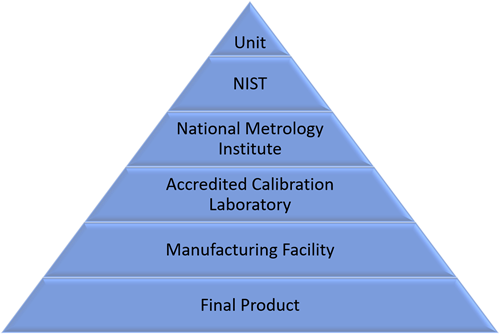Calibration Basics Part III - Traceability

This is Part III of our Calibration Basics Series.
In Part I, we looked into the general overview of what calibration is. While a rather simple concept, it is still extremely important to keep those basics straight.
In Part II, we dove into what happens when your calibration process finds a piece of equipment to be reading off.
In this post, we will discuss the most important cornerstone affecting accuracy in calibration, traceability.
If you have been reading along, you now have a firm understanding on exactly what calibration is and where adjustment fits into the calibration process.
The astute reader will notice one obvious flaw in the example we have been using of the bathroom scale. What happens if the weight being used to calibrate the scale is inaccurate? Won't that throw the whole process off?
Don't worry - there is an answer for that. Traceability.
Traceability
To take a deeper look into traceability, let's head back to our example of the weight loss program and the scale.
Perhaps, after completing the calibration of your bathroom scale, you find it to be reading perfectly accurate. Crap. This can't be right. Because, "of course you lost weight" (heavy sarcasm). Well, the only logical solution is that the weight used to check the scale must not actually weigh what it says it does, right (heavy sarcasm, again)? How do we assure this is not the case?
The answer is through a concept called traceability.
Traceability is the link from the measurement result back to the theoretical concept of the unit you are trying to measure - in this example, a pound. This means that by using a traceable calibration process, you can guarantee that the reference you are using is a fair representation of this measurement unit. This concept applies for all units of measurement, inches, seconds, volts and so forth.
The Ultimate Standard
In order for this process to work, there must be a "keeper" of the ultimate standard being referenced. In the United States, this "keeper" is National Institute of Standards and Technology (NIST). They are the ones who define what, exactly, is a pound (or an inch, second, volt and so forth).
Why have these ultimate standards? Some units of measurement are calculated, thus easy to define. For example, a BTU (British Thermal Unit) is defined as the amount of heat required to raise the temperature of one pound of water by one degree Fahrenheit.
But what, exactly, is a pound? Unfortunately, the pound is a rather abstract, theoretical concept that is derived from an arbitrary decision thousands of years ago. To further confuse this matter, many units of measure were developed in a similar fashion.
As you can imagine, when it comes to these theoretical units of measure, it would be quite easy to lose track over time of what, exactly, this base unit of measure is. Without this, it would be possible, in say a few hundred years, for the commonly accepted theory of an inch to ACTUALLY measure 1.5".
Why Traceability is Needed
At this point, you might be saying "What's the big deal?". Well, the big deal is that without a commonly accepted definition of a unit of measure, NOTHING WOULD WORK.
In today's day and age, rarely is the complete and final product created by the same company. If nothing else, they are at least buying nuts and bolts from another manufacturer. Now imagine, if their definitions of an inch were 1/4" different from each other...
Traceability In Calibration
So back to the question at hand. How can we be sure the weight being used to calibrate the scale is actually the weight it says it is? You guessed it: traceability.
The only way to 100% ensure that the scale is reading accurately, is through a traceable calibration. Our friends at NIST have luckily provided us a working definition of this:
Traceability of measurement requires the establishment of an unbroken chain of comparisons to stated references each with a stated uncertainty.
One of the major benefits of having an ISO 17025 accredited calibration is that each calibration uses standards (the weight in our bathroom scale example) that is traceable to NIST.
The basic process is this. Each piece of equipment used to calibrate another piece of equipment, needs to be calibrated, itself, by a more precise standard. This process repeats itself until the chain reaches the NIST standard. A graphical example would look like this:


Here's how this works:
- The final product is produced by the manufacturer
- The manufacturer verifies this final product with a piece of measuring & test equipment (M&TE)
- This piece of M&TE is calibrated by the accredited calibration laboratory with their calibration standard
- Their calibration standard is calibrated by a higher level National Metrology Institute (or other calibration lab) using their own standards
- These standards are calibrated by NIST, using their "ultimate" standards
- The NIST standards represent the theoretical unit of measure
As you can see here, by following this process, any manufacturer (or organization requiring measurement) can ensure that the product they are producing is as accurate as possible, within acceptable uncertainties. The good news is, you don't have to worry about this. By using an ISO 17025 accredited calibration provider, such as Fox Valley Metrology, you are automatically receiving this level of assurance.
As can be seen on our certificates, we automatically provide you with this information. Additionally, the full NIST traceability hierarchy of each of your assets can be explored on Metrology360, our free online gage management software.
Isn't that a sweet deal?
You may be asking, "But wait, what are these acceptable uncertainties you mentioned?" Learn all about this concept and more in Part IV of our Calibration Basics Series.
Interested in having your gages calibrated? Check out our Calibration Services today!
